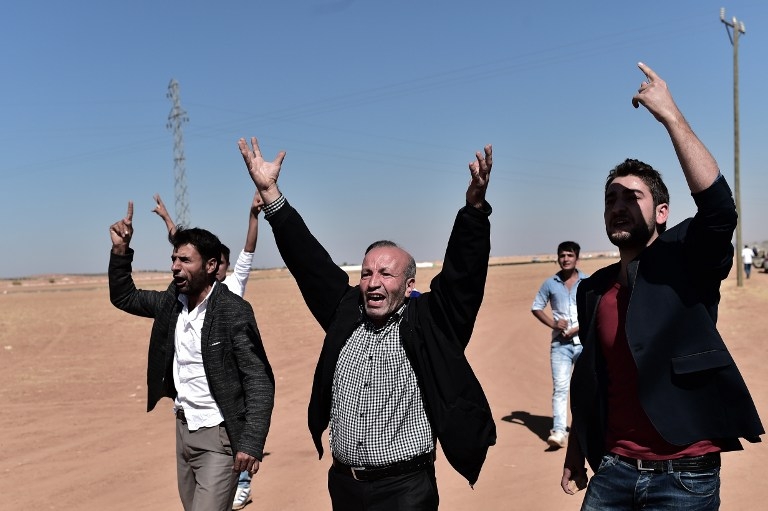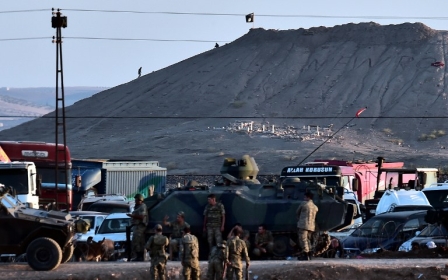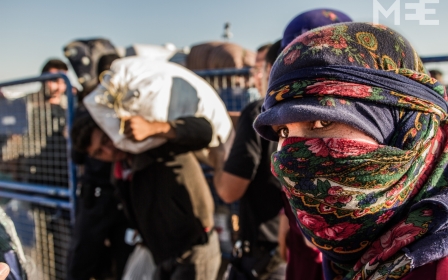Analysis: The fall of Kobane and its consequences

Desperate sieges in which heroic defenders are slaughtered to the last man and woman, but whose story then fires the imagination and militancy of later generations, are part of many national histories: the Alamo in Texas in 1838; the explosion at Arkadi Monastery in Crete in 1866; the Easter Rising in Dublin in 1916.
The fall of the small Syrian town of Ain al-Arab or Kobane to the forces of IS on Monday afternoon may be a new addition to this list, not least since its destruction was witnessed by the world’s press watching helplessly from just a few hundred metres away across the Turkish border.
Knowing that they were doomed without international help, the Syrian Kurdish PYD bombarded the outside world with messages for help first to Turkey and then to the US and the anti-alliance. Kurdish demonstrators held meetings in support of Kobane in London and other Western cities but did not shift international attitudes. Despite a pledge from its prime minister, Mr Ahmet Davutoğlu on 2 October that Turkey would do everything it could to stop the IS advance. Turkey did nothing. It could easily have sent troops or allowed weaponry to pass just a few hundred metres to the defenders.
For its part, the US coalition did make a few airstrikes last weekend against dispersed IS positions around Kobane, though it must have been aware that these would make almost no difference. US officials remained silent or at best evasive on the town’s plight, as did EU leaders. Had they spoken up, official attitudes in Turkey might possibly have shifted.
Under growing pressure from advancing IS forces for 19 days and promising that they would fight to the end, Kobane’s defence crumbled before IS. During Sunday evening and Monday morning, IS forces took control of the hills around Kobane, planting their flag on the key point, Mishtenur hill, just after midday on Monday.
Control of the heights enabled IS to increase shelling of the town below, thus reducing losses in the grim final struggle to take street by street—a very difficult military task in modern Middle Eastern towns where multi-storey apartment blocks provide almost unlimited scope for sharpshooters.
During the town’s death throes, Kobane’s defenders struggled simply to kill as many IS militants as they could. These defenders included, perhaps uniquely in recent Middle Eastern history, women soldiers: the PYD is a secularist leftwing movement. One of their leaders, Arin Mirkan, was reported to have killed a group single-handed in a suicide attack on Mishtenur hill on Sunday when she mingled with the invaders and then detonated a bomb. Three thousand civilians were thought to still be inside the city on Monday morning and some truckloads were taking women and children to Turkey late Monday afternoon. Behind them was what observers in Turkey described as the sound of very loud firing and explosions. But IS’s black flag was beginning to appear over buildings.
The general expectation among the defenders was clearly that if they did not die fighting, they would perish soon afterwards at the hands of IS executioners who regard them as infidels. They were also determined not to purchase survival by surrendering their autonomy. On Saturday, a PYD leader, Salih Moslem, visited Turkey for a few hours in a last ditch attempt to negotiate a deal with Turkey to rescue the town. Moslem was reportedly told that help depended on the Syrian Kurds giving up their claim to self-government, disbanding their canton system, and permitting a Turkish safe zone. He refused and returned to Syria to carry on fighting with an inevitable end.
However, the loss of Kobane will have strategic and political fall-out which is likely to be very extensive. The fall of Kobane means that IS is now firmly established as a neighbour of Turkey’s with Mürşıtpınar and Akçakale and other key crossings in IS hands—and IS tanks, admittedly not in great numbers, can be seen across the frontier. Dozens of Turkish tanks line the border, pointing south.
Syrian Kurds now control only two widely separate exclaves along the border, around Qamishly in the east and Afrin in the West, with IS holding about half of the 900 km frontier.
Though they appear to be increasing their military readiness, the Turkish authorities have not spoken yet of possible operations and their sights still seem to be on ending the Assad government in Syria which it regards as a prelude to stopping IS. They also say the PKK (with which it is negotiating peace) is as much an enemy as IS.
Turkey has several times repeated that it wants a no fly zone (IS has no planes but Bashar Assad does) and safe-zones south of the border. These conditions apply also to facilitating US operations out of the İncirlik Airbase near Adana. So far, the US seems cool to these suggestions. Without the US, Turkey at present looks unlikely to move.
However, Kobane has also left Ankara with a major image problem both with its own Kurds. Angry crowds gathered in at least three eastern cities, Hakkari, Van, and Iğdır, outside local AKP offices on Monday evening.
Internationally, the scenes on the Turkish side of the border may also prove expensive. Film of the teargassing by police of a car carrying BBC correspondents at the border has few precedents in news journalism. Uncertainty about Turkey’s attitude to IS persists in some quarters despite vigorous denials by the politicians.
On Sunday, for example, Anatolia, the state news agency, tweeted that the Eid holiday was being held peacefully in the IS capital Ar-Raqqa. The tweet was swiftly taken down but it was not explained.
Turkish leaders responded furiously to clumsy suggestions by US Vice President Joe Biden that Turkey had inadvertently helped cause the rise of IS. They got a vice-presidential apology, but the tough language they used suggested that they had forgotten the need to conciliate allied and world opinion. Nor have they responded to fears among many Turks that after 90 years of standing outside Middle East conflicts, Turkey risks being sucked into regional violence by the Syrian conflict just as Pakistan was by Afghanistan.
But the biggest immediate uncertainty is whether Turkey’s Peace Process with the Kurds can now carry on or whether the country could face renewed terrorist attacks from the PKK as well as IS.
Middle East Eye propose une couverture et une analyse indépendantes et incomparables du Moyen-Orient, de l’Afrique du Nord et d’autres régions du monde. Pour en savoir plus sur la reprise de ce contenu et les frais qui s’appliquent, veuillez remplir ce formulaire [en anglais]. Pour en savoir plus sur MEE, cliquez ici [en anglais].




